Abstract
Xeroderma pigmentosum (XP) is an autosomal recessive human disease, characterized by an extreme sensitivity to sunlight, caused by the inability of cells to repair UV light-induced damage to DNA. Cell fusion was used to transfer fragments of Chinese hamster ovary (CHO) chromosomes into XP cells. The hybrid cells exhibited UV resistance and DNA repair characteristics comparable to those expressed by CHO cells, and their DNA had greater homology with CHO DNA than did the DNA from XP cells. Control experiments consisted of fusion of irradiated and unirradiated XP cells and repeated exposure of unfused XP cells to UV doses used for hybrid selection. These treatments did not result in an increase in UV resistance, repair capability, or homology with CHO DNA. The hybrid cell lines do not, therefore, appear to be XP revertants. The establishment of these stable hybrid cell lines is an initial step toward identifying and cloning CHO DNA repair genes that complement the XP defect in human cells. The method should also be applicable to cloning genes for other diseases, such as ataxia-telangiectasia and Fanconi's anemia.
Full text
PDF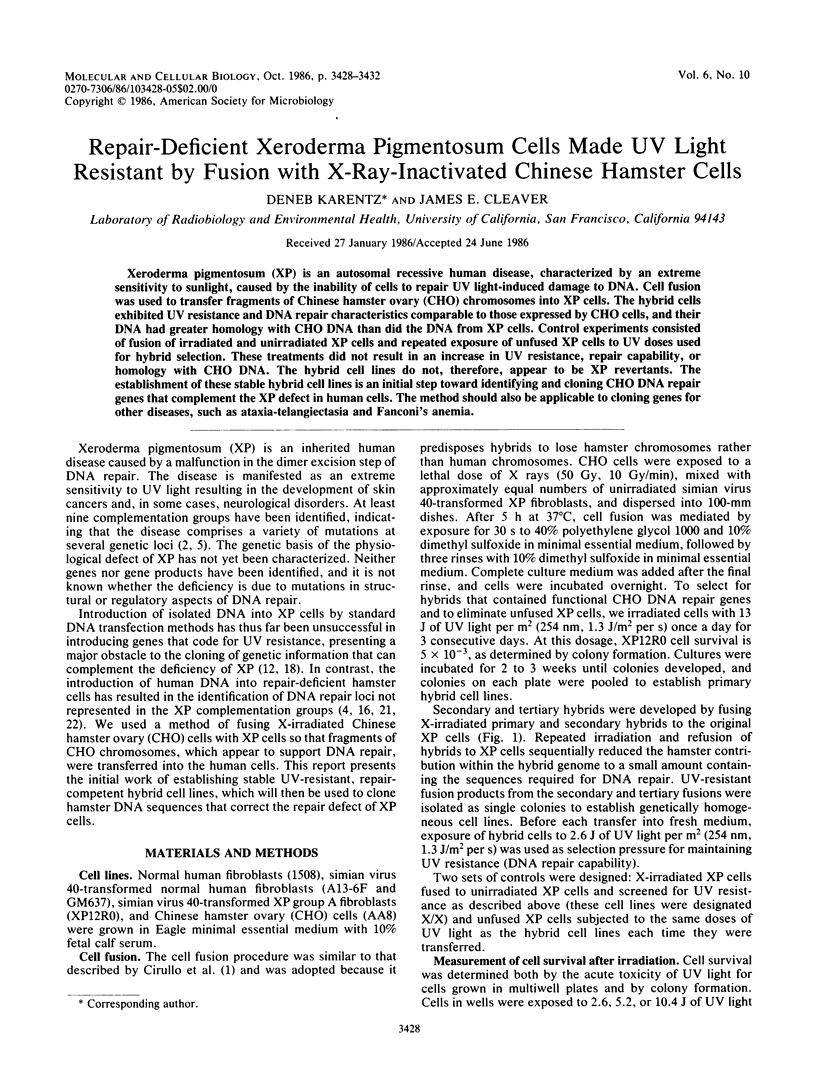
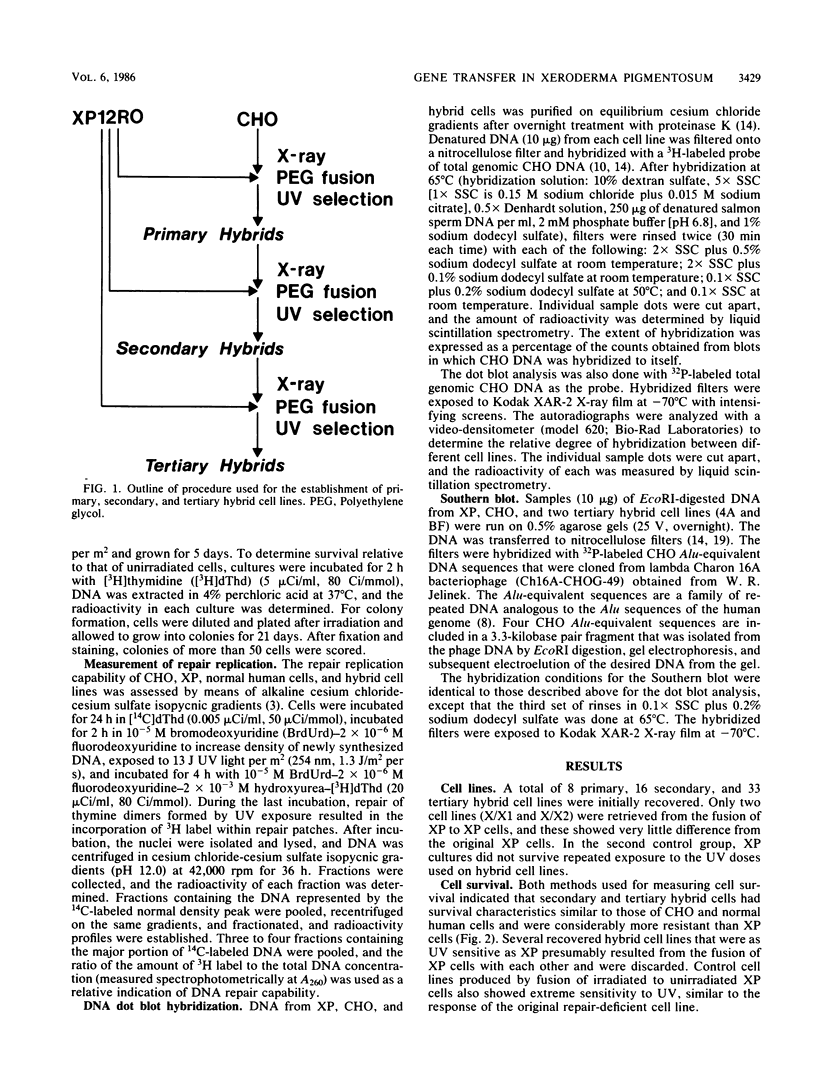
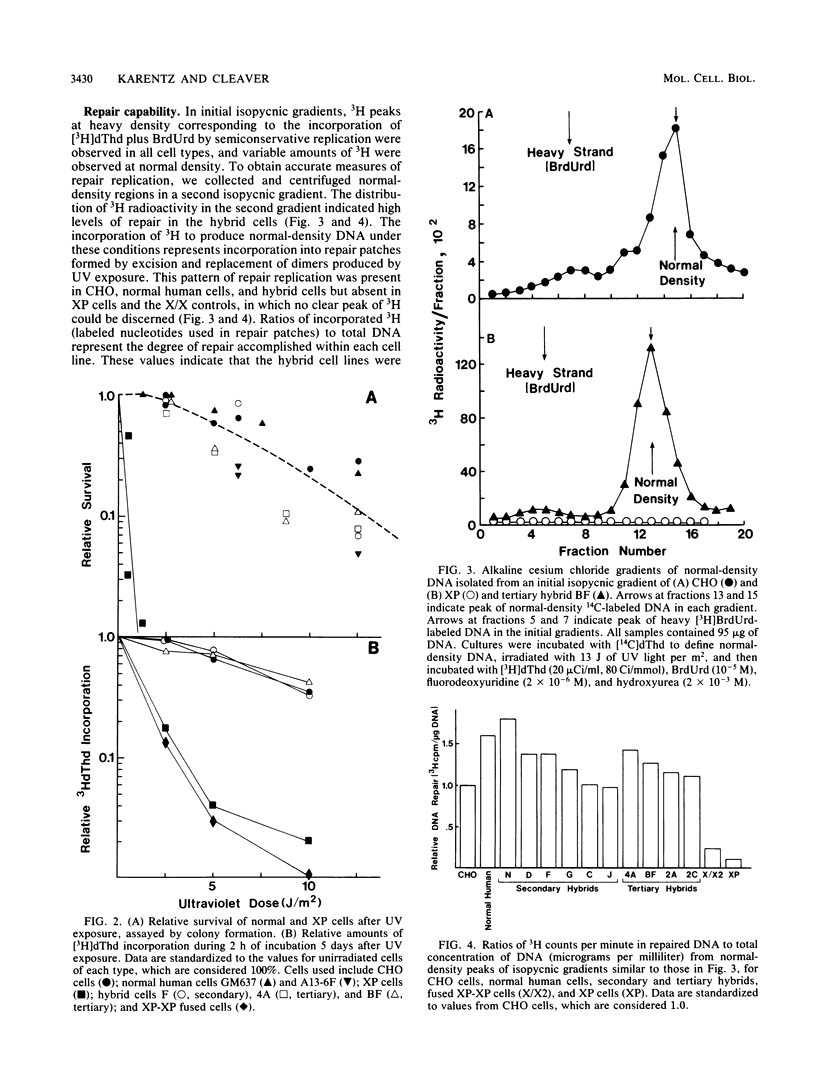
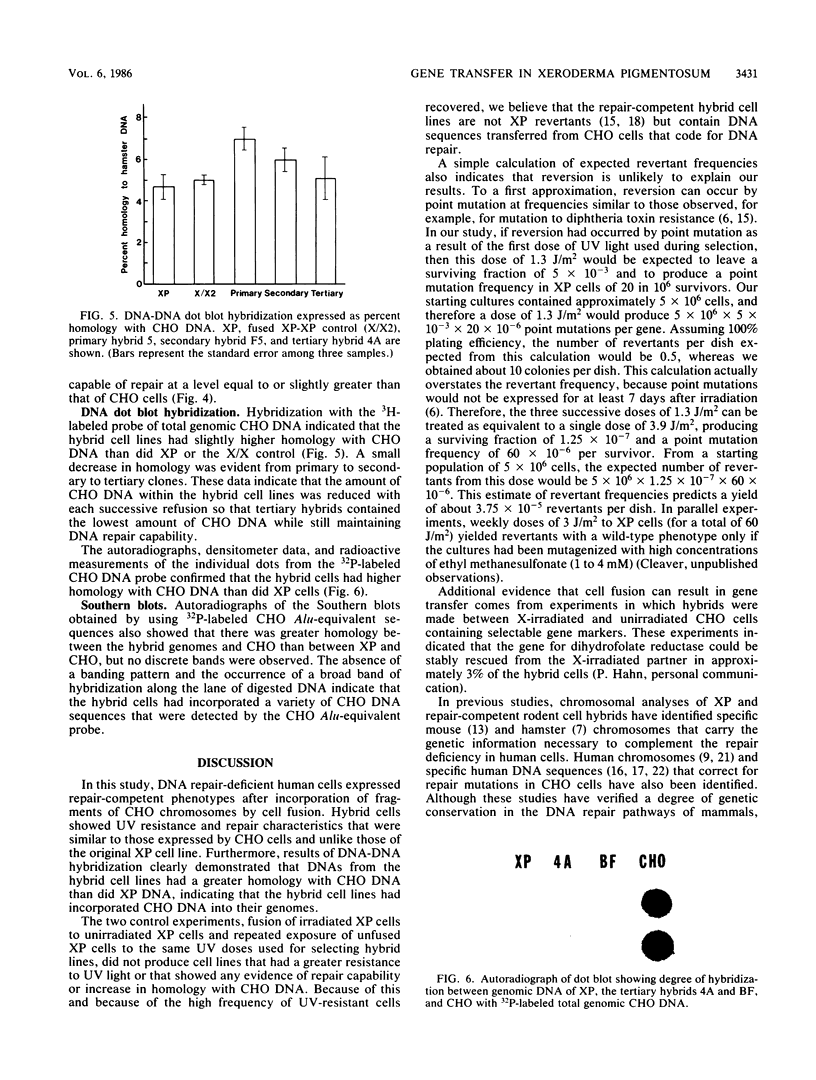
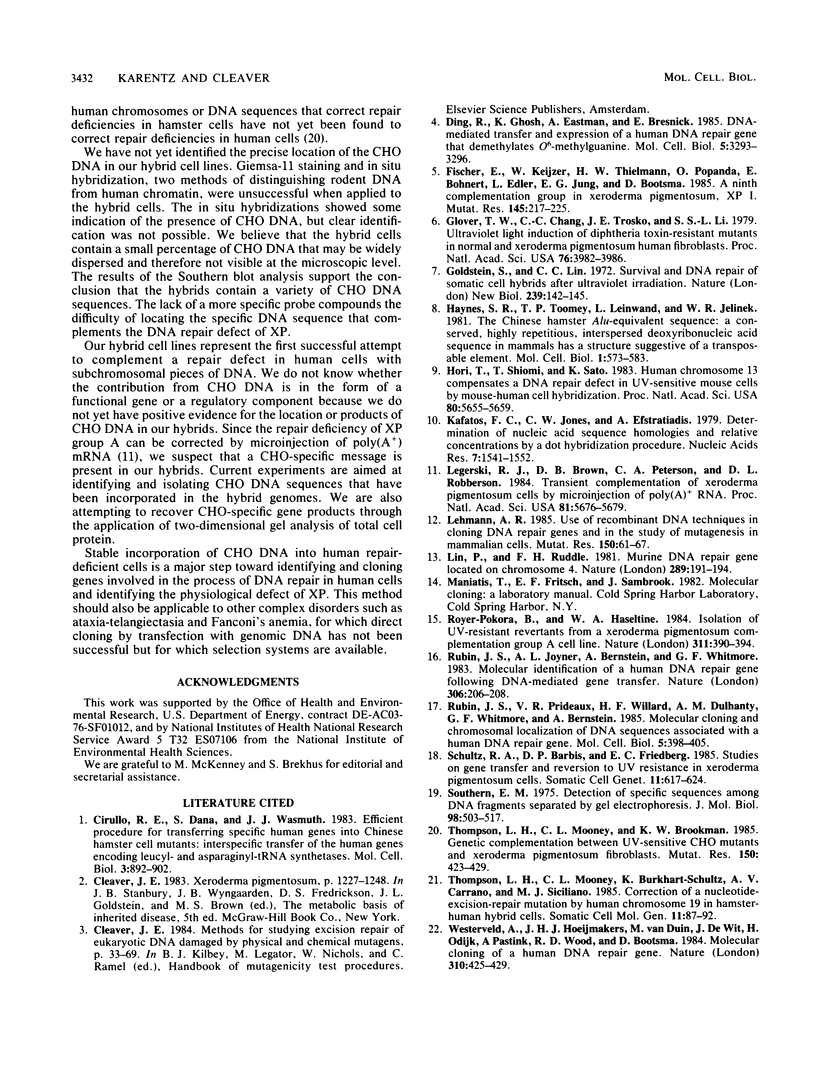
Images in this article
Selected References
These references are in PubMed. This may not be the complete list of references from this article.
- Cirullo R. E., Dana S., Wasmuth J. J. Efficient procedure for transferring specific human genes into Chinese hamster cell mutants: interspecific transfer of the human genes encoding leucyl- and asparaginyl-tRNA synthetases. Mol Cell Biol. 1983 May;3(5):892–902. doi: 10.1128/mcb.3.5.892. [DOI] [PMC free article] [PubMed] [Google Scholar]
- Ding R., Ghosh K., Eastman A., Bresnick E. DNA-mediated transfer and expression of a human DNA repair gene that demethylates O6-methylguanine. Mol Cell Biol. 1985 Nov;5(11):3293–3296. doi: 10.1128/mcb.5.11.3293. [DOI] [PMC free article] [PubMed] [Google Scholar]
- Fischer E., Keijzer W., Thielmann H. W., Popanda O., Bohnert E., Edler L., Jung E. G., Bootsma D. A ninth complementation group in xeroderma pigmentosum, XP I. Mutat Res. 1985 May;145(3):217–225. doi: 10.1016/0167-8817(85)90030-6. [DOI] [PubMed] [Google Scholar]
- Glover T. W., Chang C. C., Trosko J. E., Li S. S. Ultraviolet light induction of diphtheria toxin-resistant mutants of normal and xeroderma pigmentosum human fibroblasts. Proc Natl Acad Sci U S A. 1979 Aug;76(8):3982–3986. doi: 10.1073/pnas.76.8.3982. [DOI] [PMC free article] [PubMed] [Google Scholar]
- Goldstein S., Lin C. C. Survival and DNA repair of somatic cell hybrids after ultraviolet irradiation. Nat New Biol. 1972 Oct 4;239(92):142–145. doi: 10.1038/newbio239142a0. [DOI] [PubMed] [Google Scholar]
- Haynes S. R., Toomey T. P., Leinwand L., Jelinek W. R. The Chinese hamster Alu-equivalent sequence: a conserved highly repetitious, interspersed deoxyribonucleic acid sequence in mammals has a structure suggestive of a transposable element. Mol Cell Biol. 1981 Jul;1(7):573–583. doi: 10.1128/mcb.1.7.573. [DOI] [PMC free article] [PubMed] [Google Scholar]
- Hori T., Shiomi T., Sato K. Human chromosome 13 compensates a DNA repair defect in UV-sensitive mouse cells by mouse--human cell hybridization. Proc Natl Acad Sci U S A. 1983 Sep;80(18):5655–5659. doi: 10.1073/pnas.80.18.5655. [DOI] [PMC free article] [PubMed] [Google Scholar]
- Kafatos F. C., Jones C. W., Efstratiadis A. Determination of nucleic acid sequence homologies and relative concentrations by a dot hybridization procedure. Nucleic Acids Res. 1979 Nov 24;7(6):1541–1552. doi: 10.1093/nar/7.6.1541. [DOI] [PMC free article] [PubMed] [Google Scholar]
- Legerski R. J., Brown D. B., Peterson C. A., Robberson D. L. Transient complementation of xeroderma pigmentosum cells by microinjection of poly(A)+ RNA. Proc Natl Acad Sci U S A. 1984 Sep;81(18):5676–5679. doi: 10.1073/pnas.81.18.5676. [DOI] [PMC free article] [PubMed] [Google Scholar]
- Lehmann A. R. Use of recombinant DNA techniques in cloning DNA repair genes and in the study of mutagenesis in mammalian cells. Mutat Res. 1985 Jun-Jul;150(1-2):61–67. doi: 10.1016/0027-5107(85)90101-0. [DOI] [PubMed] [Google Scholar]
- Lin P. F., Ruddle F. H. Murine DNA repair gene located on chromosome 4. Nature. 1981 Jan 15;289(5794):191–194. doi: 10.1038/289191a0. [DOI] [PubMed] [Google Scholar]
- Royer-Pokora B., Haseltine W. A. Isolation of UV-resistant revertants from a xeroderma pigmentosum complementation group A cell line. 1984 Sep 27-Oct 3Nature. 311(5984):390–392. doi: 10.1038/311390a0. [DOI] [PubMed] [Google Scholar]
- Rubin J. S., Joyner A. L., Bernstein A., Whitmore G. F. Molecular identification of a human DNA repair gene following DNA-mediated gene transfer. Nature. 1983 Nov 10;306(5939):206–208. doi: 10.1038/306206a0. [DOI] [PubMed] [Google Scholar]
- Rubin J. S., Prideaux V. R., Willard H. F., Dulhanty A. M., Whitmore G. F., Bernstein A. Molecular cloning and chromosomal localization of DNA sequences associated with a human DNA repair gene. Mol Cell Biol. 1985 Feb;5(2):398–405. doi: 10.1128/mcb.5.2.398. [DOI] [PMC free article] [PubMed] [Google Scholar]
- Schultz R. A., Barbis D. P., Friedberg E. C. Studies on gene transfer and reversion to UV resistance in xeroderma pigmentosum cells. Somat Cell Mol Genet. 1985 Nov;11(6):617–624. doi: 10.1007/BF01534726. [DOI] [PubMed] [Google Scholar]
- Southern E. M. Detection of specific sequences among DNA fragments separated by gel electrophoresis. J Mol Biol. 1975 Nov 5;98(3):503–517. doi: 10.1016/s0022-2836(75)80083-0. [DOI] [PubMed] [Google Scholar]
- Thompson L. H., Mooney C. L., Brookman K. W. Genetic complementation between UV-sensitive CHO mutants and xeroderma pigmentosum fibroblasts. Mutat Res. 1985 Jun-Jul;150(1-2):423–429. doi: 10.1016/0027-5107(85)90139-3. [DOI] [PubMed] [Google Scholar]
- Thompson L. H., Mooney C. L., Burkhart-Schultz K., Carrano A. V., Siciliano M. J. Correction of a nucleotide-excision-repair mutation by human chromosome 19 in hamster-human hybrid cells. Somat Cell Mol Genet. 1985 Jan;11(1):87–92. doi: 10.1007/BF01534738. [DOI] [PubMed] [Google Scholar]
- Westerveld A., Hoeijmakers J. H., van Duin M., de Wit J., Odijk H., Pastink A., Wood R. D., Bootsma D. Molecular cloning of a human DNA repair gene. Nature. 1984 Aug 2;310(5976):425–429. doi: 10.1038/310425a0. [DOI] [PubMed] [Google Scholar]



